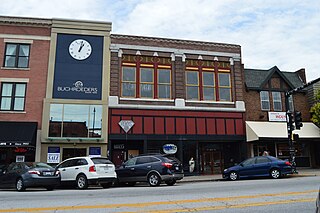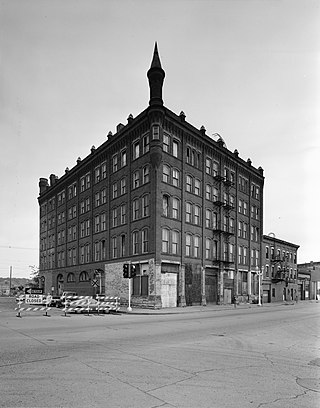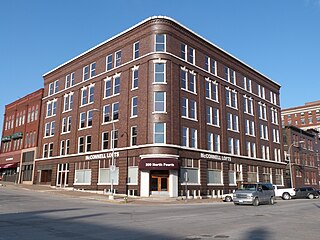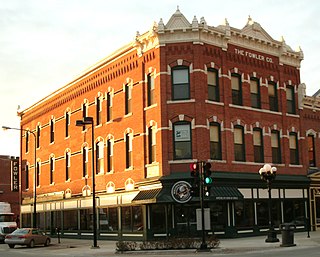
Neosho is the most populous city in Newton County, Missouri, United States, which it serves as the county seat. With a population of 12,590 as of the 2020 census, the city is a part of the Joplin, Missouri Metropolitan Statistical Area, a region with an estimated 176,849 (2011) residents. Neosho lies on the western edge of the Ozarks, in the far southwest of the state.

Building at 409 West Baltimore Street, also known as the N. Hess & Bro. Building, is a historic retail and wholesale building located at Baltimore, Maryland, United States. It is a four-story brick commercial building with a cast-iron façade above an altered storefront, erected about 1875. Built originally for a wholesale grocery company, it was subsequently occupied by a boot and shoe factory, and a series of wholesale and retail dry goods or clothing stores.

The Kress Building, also known as Kress Wholesale Company Store and Mehornay Furniture Store, is a historic commercial building located in downtown Columbia, Missouri. It was built in 1910 for the S. H. Kress & Co., and remodeled in 1946 when it became Mehornay Furniture. It is a tall two-story, brick building with an open storefront topped by horizontal metal banding, that consists of large plate glass windows.

The Odd Fellows Building in Pikeville, Kentucky is a three-story brick building that was built in 1915 and historically served as a warehouse and as a business. It was listed on the National Register of Historic Places in 1984.

The National Building is a historic warehouse building in downtown Seattle, Washington, located on the east side of Western Avenue between Spring and Madison Streets in what was historically Seattle's commission district. It is now home to the Seattle Weekly. It is a six-story plus basement brick building that covers the entire half-block. The dark red brick facade is simply decorated with piers capped with small Ionic capitals and a small cornice, which is a reproduction of the original cornice. Kingsley & Anderson of Seattle were the architects.

The Second Baptist Church, also known as Pleasant Hill Baptist Church, is a historic African-American Baptist church located at Neosho, Newton County, Missouri. It was built in 1896, and is a one-story, rectangular brick building with Gothic Revival style design elements. It sits on a stone foundation, has a gable roof, and features a projecting, centered, two-story brick belfry.

The Warfield, Pratt and Howell Company Warehouse is an historic building located in downtown Des Moines, Iowa, United States. The building was built by wholesale grocer Warfield, Pratt and Howell Company. Wilson R. Warfield and John W. Howell moved their business to Des Moines in 1860 and moved to this location in 1884. William J. Pratt joined the partnership in 1897. The structure is a six-story commercial and office building that rises 93 feet (28 m) above the ground. The prominent Des Moines architectural firm of Proudfoot & Bird designed the building, and it is considered a good example of warehouse construction from the turn of the 20th century. It was completed in 1901 with an addition completed in 1909. It features load bearing brick piers, bearing walls, and wood column and girder technology on the interior. Other wholesale firms were housed in the building after 1935. It was part of a redeveloped district in the 1980s. The building was listed on the National Register of Historic Places in 1985.

The Bishop's Block, also known as the Bishop's Block Apartments, is an historic building located in Dubuque, Iowa, United States. It was individually listed on the National Register of Historic Places in 1994. It was included as a contributing property in the Old Main Street Historic District in 2015.

The Manufacturing and Wholesale Historic District is a nationally recognized historic district located adjacent to the central business district of Burlington, Iowa, United States. It was listed on the National Register of Historic Places in 2012. At the time of its nomination it included 32 buildings of which 28 are contributing properties and 14 non-contributing properties. The tracks of the former Chicago, Burlington and Quincy Railroad bisect the district and contributed to its development. The buildings range in size from one single story office structure to two six-story buildings. Nine buildings were constructed before 1900, the earliest in 1876. The rest of the contributing buildings were built from 1900 to the 1930s. The four noncontributing buildings were built from the 1960s to the 1980s. The Romanesque Revival John Blaul and Sons Wholesale Grocery building is the only building that wasn't built in a utilitarian form with only general stylistic influences. All of the buildings are constructed in brick. The area largely housed manufacturing and wholesale businesses into the 1970s and 1980s. A few of them continue to do so into the second decade of the 21st-century.

The W. J. Armstrong Company Wholesale Grocers Building is a historic warehouse in Waseca, Minnesota, United States, constructed around the year 1900. It was built to house a wholesale grocery business and placed to take advantage of the nearby Minneapolis and St. Louis Railway tracks. The building was listed on the National Register of Historic Places in 1982 for having local significance in the themes of commerce and transportation. It was nominated for being one of the best preserved trackside buildings associated with Waseca's economic development as a rail hub. The building is now part of the Miller–Armstrong Center, a redeveloped complex containing restaurants, a conference center, and lodging.

William Buschmann Block, also known as the Buschmann Block, is a historic commercial building located at Indianapolis, Indiana. It was built in 1870–1871, and is a three-story, "L"-shaped, Italianate style brick building. It was enlarged with a four-story wing about 1879. It sits on a rubble foundation and has round arched openings with limestone lintels. The building originally housed a retail and wholesale grocery business.

Meierhoffer Sand Company Office Building was a historic office building located at Boonville, Cooper County, Missouri. It was built about 1900, and was a one-story, rectangular vernacular brick building with a gable roof. An addition was constructed about 1910 which housed a wagon scale. By 1929, the building had been used as a grocery store and was later converted to a dwelling. It has apparently been demolished.

The Fowler Company Building is a historic building located in Waterloo, Iowa, United States. It was built in 1884 by the city's most successful grocery wholesale business. They continued to operate from here until 1937. The three-story brick structure is an example of Late Victorian commercial architecture with Queen Anne influences. The building features pilasters, corbeling, canted-brick courses, and contrasting stone trim around and between the windows and at the street level. It is capped with an ornate metal cornice that contains pilasters, finials, pediments, floral and circle imagery, and quilted surface textures. It was individually listed on the National Register of Historic Places in 2009. In 2011 it was included as a contributing property in the Waterloo East Commercial Historic District.
Producers Produce Company Plant is a historic manufacturing complex located at Springfield, Greene County, Missouri. The original sections were built about 1920, and expanded through 1980. The complex consists of nine two- and three-story red brick buildings that housed a wholesale poultry packing and egg factory. They include the Poultry Storage building, Office and Packing Plant, Egg Preparation Department, Egg Drying Building, Packing Plant, two Cold Storage Buildings, Engine Room, and Freight Station.

Inter-State Grocer Company Building, also known as Bagcraft Building, is a historic factory and warehouse located at Joplin, Jasper County, Missouri. It was built in 1915, and is a five-story fireproof wholesale distribution and food processing building constructed of reinforced concrete with tapestry brick cladding and terra cotta ornamentation. Also on the property is a contributing one-story brick garage.

Robert Elliott's Wholesale Grocery is a historic commercial building located at Hannibal, Marion County, Missouri. It was built about 1886, and is a two-story brick structure. It features semicircular arches with fanlight tops on the first floor, upper windows with segmental arches, and an applied cornice, possibly metal.

Neosho High School, also known as Neosho Intermediate School, is a historic high school building located at Neosho, Newton County, Missouri. It was built in 1916–17, and is a two-story, "U"-shaped, brick and stone trimmed building with Gothic Revival and Classical Revival style design elements. The building measures approximately 101 feet by 127 feet. Also on the property is the contributing two-story giraffe rock ancillary building, built as a vocational facility for the school in 1940.

The Grocers Wholesale Company Building, also known as the Sears and Roebuck Farm Store, is a historic building located in Des Moines, Iowa, United States. Completed in 1916, this was the first of four warehouses built and owned by Iowa's only and most successful statewide cooperative grocery warehouse. It is possible that it was the first statewide organization of this kind in the country. The cooperative allowed independent grocers to compete against chain stores and survive wholesale grocers' surcharges. They leased their first warehouse after they organized in 1912. Each successive time the cooperative built a new warehouse it was larger and technologically more advanced than the previous one. This particular cooperative grew to include parts of four states: Iowa, southern Minnesota, northern Missouri and eastern Nebraska. They built their second warehouse in 1930 and moved out of this facility. They continued to own this building until 1968, and they leased it out to other firms. The Sears Farm Equipment Store began to occupy the building in 1937 and continued here until 1959. The cooperative became the Associated Grocers of Iowa in the late 1950s, and it continued in existence until 1985. The building was listed on the National Register of Historic Places in 2008.

The McCord-Brady Company, at 1506 Thomes Ave. in Cheyenne, Wyoming, was built in 1914–15. It was listed on the National Register of Historic Places in 2003. It has also been known as Asher-Wyoming Company Wholesale Grocers and as Cheyenne Winlectric Company.

The Ridenour-Baker Grocery Company Building in Kansas City, Missouri is a commercial building constructed in 1910 by the Ridenour-Baker Grocery Company. It was the first wholesale grocery building west of the Mississippi River to be located on the path of a railway, where goods could be shipped into it directly. The building was listed on the National Register of Historic Places in 2014.























